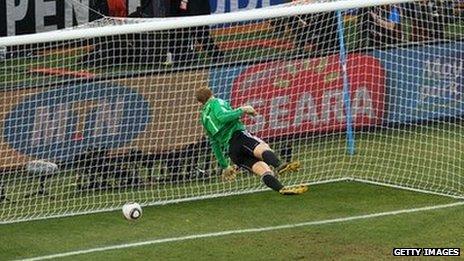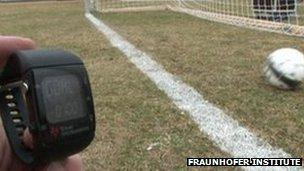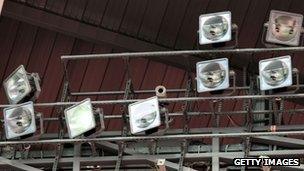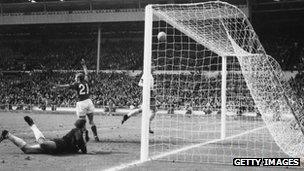Goal-line technology battle goes to shoot-out
- Published

A shot by England's Frank Lampard against Germany at the 2010 World Cup reignited the goal-line debate
A multi-million pound competition to provide world football with game-changing new technology is about to go to a penalty shoot-out.
The change in question is the introduction of goal-line technology (GLT), which was approved by world governing body Fifa and the International Football Association Board - the body that determines the laws of the game - back in the summer.
The aim of GLT is to tell whether the ball has crossed the goal-line in incidents where the referee and his assistants are unable to see for sure.
From a shortlist of 11 different companies and technologies, Fifa has given licences to two separate firms, the UK-based but Sony-owned Hawk-Eye, and Germany's GoalRef.
With Fifa yet to decide which system it will use for the 2014 World Cup, and national football leagues across the world also yet to choose between the two, the stakes are very high.
Especially when you consider the level of money involved. While the two companies are reluctant to provide exact figures, the cost of installing their systems in a football stadium have been estimated at about £250,000 for Hawk-Eye and £150,000 for GoalRef.
Japan tournament
When you multiply those figures by the number of professional football teams around the world, you are reaching rather large amounts of money. And that is before you add the follow-on annual servicing costs.

There was controversy as Ukraine were refused what appeared to be a goal against England at Euro 2012
This week GLT has been discussed at Soccerex, the global convention of football business and finance, which is being held in Rio de Janeiro, Brazil.
With the panel including senior figures from both Hawk-Eye and GoalRef, and senior Fifa official Christoph Schmidt, it was confirmed that Fifa would be testing both systems at the 2012 World Club Cup tournament, which starts next week in Japan.
Mr Schmidt said that after evaluating their performance in Japan, Fifa would then make its choice. Many national football authorities are then expected to follow its lead.
With the two firms said to be neck-and-neck, Japan will be their equivalent of a nerve-wracking penalty shoot-out.
Rapid response
But before exploring what was said at Soccerex, it is worth pausing to take a closer look at the two rival systems.
Hawk-Eye uses seven cameras focused on each goal. With the cameras fixed to the stadium roof, they give a 3D picture of the ball's exact location.

The GoalRef system works by using magnetic sensors
It is a system that has been used by both the sports of tennis and cricket for a number of years.
GoalRef by contrast, uses a system of electro-magnetism, with sensors both inside the goal posts and the match-day balls.
Each system connects to wrist bands worn by the match officials, and can alert them in under a second whether the ball crossed the goal-line.
It is important to stress that Fifa will not require any league around the world to install GLT - it will remain voluntary.
However, the top professional leagues in each country are all expected to bring in the technology, such has been the desire to eradicate incorrect goal decisions, both from fans, and clubs concerned by the potential financial implication of losing vital games - such as relegation deciders - because of refereeing mistakes.
'Fair fight'
Speaking at Soccerex, Hawk-Eye inventor Paul Hawkins said he relished the battle with GoalRef.
"Football is a great game because of the competition, and all businesses face competition," he said.

The Hawk-Eye system uses a number of cameras
"We have different technological approaches, and both of us have been working slowly and steadily.
"If both of us keep our heels clean, it should be a fair fight."
Thomas Pellkofer, operational manager at GoalRef, also said that his company welcomed the healthy competition, and he highlighted the effective simplicity of its system.
"There is a sensor in the balls, but no electricity, it is completely passive," he said.
"The ball is exactly the same for the players, it is seamless integration."
Other entrants
Yet while GoalRef and Hawk-Eye have been chosen by Fifa from an initial short-list of 11, the remaining nine companies, and other competitors, could still have their systems approved by Fifa in the future, Mr Schmidt confirmed.
He said: "The market is open to any technical companies if others come to the market."

There have been arguments about balls crossing the line for a number of decades
Mr Schmidt added that this would only be a good thing, because further competition would bring down prices.
So even with Fifa set to shortly choose either GoalRef or Hawk-Eye, it could end up then switching to a different provider of GLT in the future.
With each company only getting an initial licence for two years, this level of uncertainty is said to be putting off some football leagues from making their choice.
One official at the English Premier League told the BBC on condition of anonymity that it didn't want to be in a position where its clubs install one system at significant expense, only to then have to change it a number of years down the line.
The question of which company triumphs in the GLT marketplace could ultimately prove as controversial as the simple issue of whether the ball crossed the line has been until now.